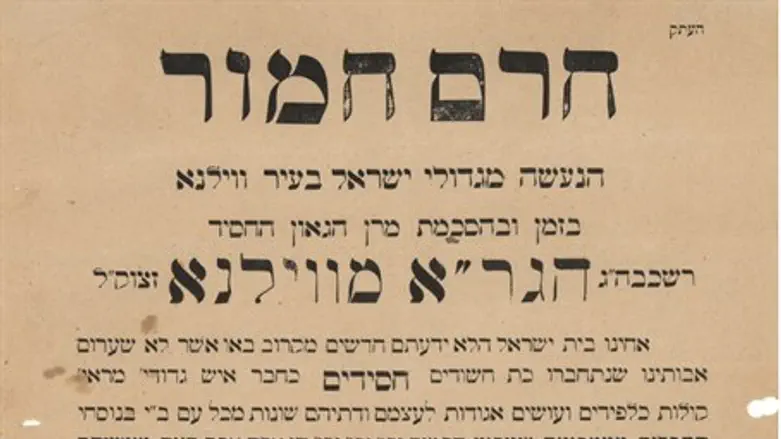
A unique manuscript offering a rare look into the tumultuous beginnings of the hassidic movement in Eastern Europe is set to go up for auction in late January.
The only existing copy of a pakshevil (wall poster) declaring the Vilna Gaon's herem (ban) of Hassidism, dating from the mid to late 19th century CE, bears testimony to one of the most renown rabbinical "herem" bans or excommunication orders in history, which formalized opposition between the Hassidic and Lithuanian or Mitnagdim (literally: Opponents) streams of hareidi Judaism.
Hassidism was established as a new religious movement in the 1750s. It was viewed with suspicion by the Mitnagdim, who considered it to be straying from the intellectual study and practice of Judaism, entering into the murky water of esoteric 'spiritualism' which placed an emphasis on dancing and singing. Many Torah scholars also opposed the movement for elevating the status of rabbis from scholars and legal arbiters to a sort of spiritual "go-between" between man and God.
The Torah sage Rabbi Eliyahu ben Shlomo Zalman, better known as the Vilna Gaon, led the opposition against the hassidim, issuing a ban to excommunicate the new movement in 1772.
This move was came partially in response to rumors that a hassidic leader had declared the Vilna Gaon to be "false and his Torah is false and his faith is false."
While some differences still exist between the two streams of Judaism, most of the tension has disappeared, and hassidic collectors have also reportedly shown interest in obtaining the pakshevil.
"Hassidic and Lithuanian collectors are very interested in this item," announced Meron Eren, head of Kedem Auction House which holds the relic. "After all, both feel a connection to this item."
Citing a joke among collectors that those hassidim who registered interest only did so in order to destroy the evidence of such strong rabbinical opposition to the movement, he said: "I sincerely doubt that anyone would really do such a thing."
The pakshevil soon to be up for auction is the only known copy of the ban publicized as a wall poster, and is a copy of the original ban from 70 to 100 years after it was made. Apparently the poster appeared during a later round of bans.
In the language of the Vilna Gaon's ban, the hassidim "seclude themselves in their own groups, and their religious practices differ from any other people." Their style of prayers, known today as nusach sefarad, is referred to as "one of a thousand of their despicable ways."
"Therefore, the leaders of our people must don the cloak of zealousness, zealousness for God, to destroy, annihilate and declare upon them excommunication and bans and curses," concludes the fiery declaration, adding that the dispersion of the hassidim "is for the good of the world."
The ban notes that hassidim had already been "uprooted" from Vilna, declaring "just as we have uprooted them from here, so they shall be uprooted from all places, not to be remembered or taken into account or considered ever again. And any trace found anywhere must be uprooted, not to leave any root in the land."
